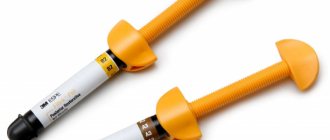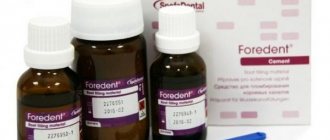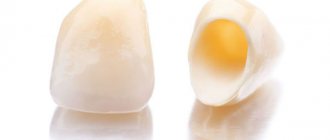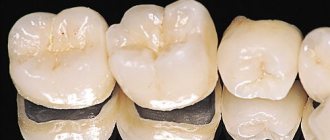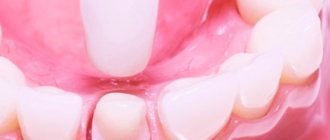10.12.2019
Quite often, after an initial dental treatment session with a dentist, the patient returns home with a temporary filling. Many people are beginning to wonder why it is not possible to put in a long-term option to eliminate return visits and whether temporary fillings are simply a way for doctors to make extra money.
Content:
- Why are temporary fillings placed?
- Why use it - indications for use
- How long can you walk with such protection?
- Manufacturing materials
- How does the installation work?
- Rules of care
- If the coating collapses prematurely
- How does the replacement work?
Often, patients at dental clinics are faced with a situation where the doctor gives them a cheap intermediate filling and indicates the day when they need to come back for a follow-up appointment to replace it with a permanent one. We suggest you understand this treatment tactics and its features.
Recommendations
The Doctor Martin Clinic provides services for the treatment of patients with the installation of a temporary filling, if this stage is necessary for more effective treatment. Our center provides guarantees for the work of specialists and materials, however, the possibility of temporary fillings falling out cannot be ruled out.
To reduce the risk of opening a tooth cavity when a filling falls out, our experts recommend:
- use low-hardness brushes for dental care;
- reduce the load on the affected tooth;
- exclude the influence of sudden temperature changes (including eating dishes of different temperatures);
- Do not touch the fillings with your tongue or any objects.
Installation of a temporary filling is a mandatory intermediate step in the treatment of many dental diseases.
Compliance with all recommendations, the professionalism of the doctor and high-quality materials reduce the likelihood of temporary fillings falling out to a minimum. If the filling does fall out, we recommend contacting our specialists for advice and making an appointment as soon as possible.
Why are temporary fillings placed?
They are intended for:
- protecting the damaged dental area from the destructive influence of pathogens;
- preventing the accumulation of food debris in the carious “hollow”;
- reliable fixation of the applied medicinal mixture.
Under the filling material there is always a special medicine that treats the unit from the inside, or a paste that kills the nerve. It turns out that a non-permanent filling is indicated in cases where multi-stage therapy is carried out.
Tsivinsky's technique
Classic dental filling in a dental clinic involves the use of a drill, which drills out carious lesions. Doctor Tsivinsky has developed his own unique technique, which makes it possible not to use the drilling method. Therefore, the procedure will be painless and simple. The doctor proposed his own patented composition - a powder mixture called “Santedex”. The drug is freely available at pharmacies. Contains biologically compatible ingredients that do not cause allergic reactions. This method allows you to place some of the most reliable dental fillings at home.
Before the procedure, it is necessary to knead the composite. To do this, you need to take the dry mixture that comes in the kit and combine it with a special liquid solution. The substance must be continuously stirred to obtain a sufficiently dense material. Then the cavity in the tooth is prepared, where the filling is supposed to be installed. It is extremely important to thoroughly clean your teeth with hygienic paste and treat the canal that is affected by caries. It is advisable to do the filling at night, so that during the night the composition performs a therapeutic function. In the morning, the product can be removed and filled with a filling. For many people, the procedure raises a lot of questions. This method will help maintain normal dental health for some time. Some people who use Santedex claim that such fillings can last for years. According to the author of the method, his drug is capable of performing the following actions:
- Block the development of inflammation.
- Disinfect the area.
Why use it - indications for use
Dentists install temporary filling compounds for:
- Advanced caries. If the cavity is very deep, after it has been cleansed of the affected tissue, a medicinal solution is applied to make the layer between the open area of the crown and the dentin as strong as possible.
- Progressive acute pulpitis. Requires depulpation. For this purpose, a medicine is placed into the “hole” that destroys the nerve. It is covered with a protective insulating compound, which will be replaced in the future.
- Periodontitis. With this disease, progressive inflammation in the root area is observed. To stop it, the dentist puts an antiseptic medicine inside the canals. To securely fix it, a hardening gel is placed on top.
- Complicated carious process. Sometimes dentists are faced with a non-standard course of a diagnosed disease. Then, in order to select an effective treatment, they decide to observe the dynamics. In this case, there is no point in installing a permanent element - it will most likely have to be removed soon. Therefore, preference is given to the temporary.
- Manufacturing of dental crowns and bridges. After impressions are taken, it is important to protect the sawn parts of the unit. To do this, use a temporary filling or crown.
Sometimes non-permanent filling is used during the sanitation of dental canals. This is necessary to prevent recurrence of the treated disease. The specialist thoroughly cleans all intradental areas, then applies an antiseptic and closes it on top for a certain period of time. During repeated appointments, he uses permanent hardening mixtures.
Drugs placed under a sealed barrier
The service life of the temporary plug initially depends on the drug put into it:
- Arsenic is used to kill the nerve in the tooth for subsequent depulpation. For this purpose, a number of other toxic substances are used, which help not only to painlessly remove the nerve, but also to subject the entire pulp tissue to necrosis;
- To treat periodontitis or pulpitis, antiseptics or antibiotics are used to relieve inflammation. Such a filling is usually worn for about 20 days until the infection is completely suppressed.
How long can you walk with such protection?
Compliance with the terms of wearing is a guarantee that nothing will happen to the tooth. If time is missed, the medicine placed inside the unit will begin to destroy its walls. It will also become leaky, which means that pathogenic microorganisms will begin to actively multiply in the resulting microgaps.
The exact wearing period depends on the characteristics of the material used and the dental diagnosis. The doctor calls him. If we are talking about a paste that destroys nerve tissue, then it is removed after 5-10 days. It happens that you have to repeat the procedure several times, but there is nothing to worry about. If the composition is placed inside the unit to stimulate regeneration processes, then therapy takes about two to three weeks.
Treatment process
People faced with such a problem are interested in how the tooth will be treated when the filling has fallen out. It all depends on individual characteristics, so it is worth considering the most common situations.
If the carious cavity is too large, it makes no sense to fill it again. The material will not hold and will fall out again after a short time. Therefore, the doctor will suggest alternative methods of eliminating the defect, most likely installing a crown.
If repeated caries occurs, pulpitis or other diseases develop, they must first be cured. The doctor prescribes and carries out all the necessary measures and, after complete recovery, places a new filling. If the filling material falls out of a pulpless tooth, re-filling is often also ineffective. In this case, the specialist will recommend installing a pin.
Methods for restoring the integrity of a tooth depend on its condition, so it is difficult to suggest a treatment plan without a preliminary examination.
Manufacturing materials
When choosing a composition for temporary closure of a carious cavity, the following are taken into account:
- size of the lesion;
- diagnosis;
- expected duration of treatment;
- the patient is allergic to medications.
Most often, doctors use the following intermediate-acting filling solutions:
- From kaolin and zinc sulfate. The mixture allows you to partially restore dentin - the hard crown part located under the enamel.
- Polycarboxylate. Low-toxic cement used to fix a crown, inlay or dental bridge. Can act as an insulating gasket when installing amalgam and cement elements.
- Karyosan. Zinc oxyeugenol cement, formed by zinc oxide and eugenol. Shows analgesic and antiseptic properties. Used to disinfect canals and relieve inflammation.
- Vinoxol. Includes zinc oxide and a solution of polystyrene in guaiacol. High-quality artificial dentin that can withstand chewing load for one to two months.
- Glass ionomer cement. Suitable if you need to fix dentures for a short period of time.
How does the installation work?
Since the composition is intermediate and is laid down for a specific purpose, it is logical that its use is preceded by certain preparatory manipulations:
- The doctor cleans the affected area using a drill and medical instruments. He carefully removes the remnants of altered tissue to prevent further destruction of the crown.
- Then it processes the channels. There are two options here - either the nerve is removed immediately, followed by washing the roots with an antiseptic, or a medicinal mixture is applied.
- A filling is placed on top, which will soon be replaced.
- Before letting the patient go, the dentist tells you how to care for the tooth , when to come next time, and what to do if the mixture falls out prematurely.
Application of Acrodent
In addition to the drug mentioned above, the drug Acrodent is also actively used. It is advisable to use it as a permanent filling. For the procedure you will need: a household hair dryer, cotton swabs, Chlorhexidine, a special spatula. The kit includes detailed instructions that describe the entire procedure, which consists of several stages:
- Brushing your teeth with toothpaste.
- Treating a diseased tooth with antiseptic and cotton wool.
- Drying the area.
- Then you need to apply an oxidizing agent and dry the area again.
- To prevent saliva from entering the open cavity, pieces of cotton wool should be used.
- Now a special mixture is being prepared, which will be used as a filling.
- The bottom of the cavity needs to be filled with a small volume of solution.
If the cavity is large, it will require two fillings to completely fill it. Such work is unacceptable for advanced caries and acute toothache.
Rules of care
A temporary “barrier” is less durable than a permanent one. He is able to cope with the chewing load for up to two to three weeks. If you "carry" it, it will collapse or fall out. In this regard, until the dentist replaces it with a permanent one, it is important to follow the following rules:
- Avoid eating too solid foods. Nuts, crackers, seeds, etc. are prohibited.
- Do not use chewing gum or sticky candies.
- Carry out hygienic cleaning twice a day - in the morning and in the evening after meals. Use only a brush with soft bristles.
- Do not use a paste containing abrasive particles during treatment.
- After each meal, hygienically rinse the mouth with warm water.
By keeping these rules in mind, you can significantly reduce the likelihood of destruction of the established composition.
Prevention of caries
The easiest way to avoid fillings or minimize the number of fillings is to visit your dentist regularly. This should be done at least once every six months. Simple tips will also help keep your teeth healthy:
- Careful hygiene. You need to brush your teeth with a high-quality brush and toothpaste at least twice a day.
- Using dental floss will help remove plaque from hard-to-reach places.
- Rinsing with special liquids will also help keep your gums healthy, which play a huge role in keeping your mouth healthy.
- A balanced diet will help ensure you have enough vitamins and minerals to keep your teeth strong.
Now we treat teeth even better!
Treatment, re-treatment of canals, elimination of caries under a microscope without damaging healthy tooth tissue.
We do everything to save your own tooth. Consultation with specialists is FREE!
More details
If the coating collapses prematurely
It happens that one day a person notices that the carious cavity is left without protection. No need to panic. The fact that a diseased tooth is open to invasion by pathogenic microflora is bad, but it is easy to fix. You should immediately visit your dentist to have it refilled.
If for some reason it is impossible to do this, and the visit has to be postponed by several days, you should monitor the condition of the “hole” and ensure that food debris does not collect in it. See your doctor as soon as possible.
Under no circumstances should you close an open cavity with chewing gum, gauze, cotton wool or other improvised means. These measures will worsen the situation - they will increase the likelihood of infection entering the deep tissues of the tooth.
Is it possible to close a hole in a tooth yourself?
The question often arises as to what can be used to seal a temporarily opened cavity if a filling falls out. People use a wide variety of materials for these purposes - from cotton wool to chewing gum, in general - everything that can be used to fill a hole at home. Under no circumstances should this be done. Before you tape a tooth, you should think about the consequences. The cavity will not be closed hermetically, which means food debris and bacteria will get into it.
Before you think about how to plug a tooth at home, it is worth considering that any material will create extremely favorable conditions for the proliferation of microbes and the occurrence of infection or inflammation. Therefore, the question of how to cover the tooth should not arise. To avoid the accumulation of food debris in the cavity, it should be rinsed regularly at least 6-7 times a day.
How does the replacement work?
When the medicine under the protective “barrier” stops working, a permanent filling is installed. Using a drill, the doctor removes the remaining temporary material. Then it carries out antiseptic treatment of the opened tissues. Makes sure there are no complications and then places the permanent material.
All manipulations are carried out in one visit to the doctor. They are usually comfortable and do not require the use of painkillers - after all, the inflammation has already been cured and the nerve has been removed.
Are there any contraindications
Before making a filling at home, you must make sure that there is no point in turning to a competent dentist for help. When you can’t make a filling yourself at home:
- It is not possible to eliminate the painful sensations.
- Severely progressive caries requiring root canal filling.
- Small size of the carious cavity.
- Pathological processes developing in soft tissues.
- In case of pulpitis and cysts, independent intervention is contraindicated.


